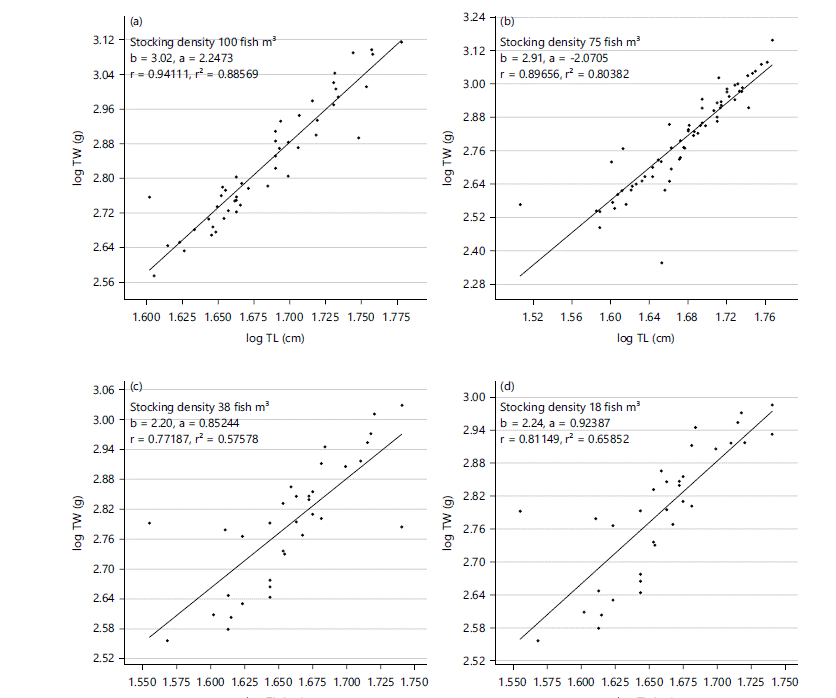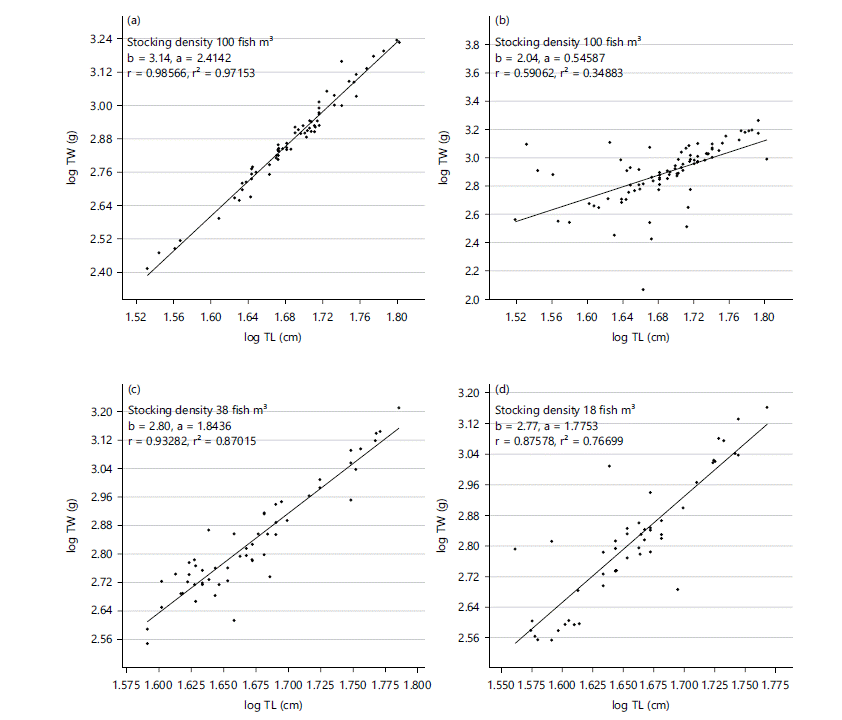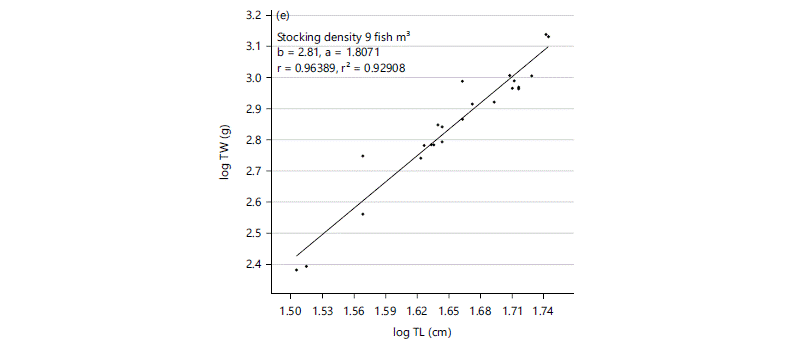Length-Weight Relationship of Hybrid Catfish Reared at Different Stocking Densities and Feeding Levels
| Received 18 Mar, 2023 |
Accepted 17 Jul, 2023 |
Published 02 Aug, 2023 |
Background and Objective: The length-weight relationship applied in aquaculture gives in-depth knowledge about the fish’s growth and general well-being. This study examined the length-weight relationship of hybrid catfish (Heteroclarias) influenced by various stocking densities and feeding levels over 12 months. Materials and Methods: Fifteen improvised tarpaulin tanks measuring 1×1×1 m3 and filled with 250 L of water were employed for this study. The study was designed to have five different stocking densities (SD1) = 100 fish/m3, (SD2) = 75 fish/m3, (SD3) = 38 fish/m3, (SD4) = 18 fish/m3 and (SD5) = 9 fish/m3 as treatments and fed three times daily using commercial feed at 1.0 and 1.5% body weight in triplicates. Data obtained were statistically analyzed using Paleontological Statistical Software (PAST). Results: The fish under study showed positive and negative allometry. Feeding level 1.5% at SD1 showed the best values for b, a, r and r2 (3.14, 2.41, 0.98 and 0.97), respectively. Feeding level 1.0% at SD5 showed the least values for b, a, r and r2 (2.66,1.64, 0,89 and 0.79). Conclusion: This study, therefore, recommends high stocking density (100 fish/m3) stocking density and a feeding level of 1.5% for optimum performance and profitability of hybrid catfish under intensive culture.
| Copyright © 2023 Ofonime Edet Afia. This is an open-access article distributed under the Creative Commons Attribution License, which permits unrestricted use, distribution, and reproduction in any medium, provided the original work is properly cited. |
INTRODUCTION
Aquaculture with the ultimate goal of producing high-quality fish seed in the highest quantity within the shortest possible time at the least cost hinges on factors such as environmental variables, good farming conditions and food availability1. For fish farmers to make an adequate profit within the shortest possible time, the best stocking density of the culture medium used should be identified.
Studies have shown that optimal stocking density is necessary to obtain the highest possible fish yields and this also depends on the amount and the quality of food available2. The number of organisms that can be stocked in a culture medium per unit area or volume is of utmost importance in the grow-out of fish as it impacts the feeding ability, growth, metabolism rate and survival of the species cultured in a specific place and time3-4.
Clarias gariepinus and Heterobranchus bidorsalis possess unique qualities which encourage their use as a crossbreed to produce a hybrid known as Heteroclarias5,6.
Length-weight model is used to predict growth in terms of weight as a function of length. The length and weight of fish increase over time is termed growth and is a major index that is used to access the well-being of a fish stock over a specific period. The length-weight relationship exhibited in fish, is a reliable means for determining the approximate weight at a specified growth length.
It is further employed in providing information on growth patterns, general health, habitat conditions, life history and fish fatness. The LWR differs among fish species based on the species’ body shape, age and spawning7,8.
Studies on the stocking densities of C. gariepinus fingerlings abound, however, there is a lack of information on the length-weight relationship of hybrid catfish under the influence of different stocking densities and feeding levels in a controlled medium and this research seeks to address the same.
MATERIALS AND METHODS
Study area: This research work was done at the fish farm complex of the Fisheries and Aquatic Environmental Management Department, University of Uyo, Uyo, Nigeria. The duration of the study was one year, from December, 2020 to November, 2021.
Experimental procedure: The experiment was designed to have five stocking densities: 100 fish/0.25 m3 (SD1), 75 fish/0.25 m3 (SD2), 38 fish/0.25 m3 (SD3), 18 fish/0.25 m3 (SD4) and 9 fish/0.25 m3 (SD5). Similarly, two feeding levels used were: 1% fresh body weight (FBW) and 1.5% FBW and feeding was thrice daily. Each treatment was triplicated. The initial weight and length of the fingerlings were taken before stocking them in the various randomly positioned tanks.
Data collection
Length and weight relationship: Length-weight relationship (LWR) was calculated from the data collected from fish samples during the experiment’s 12th month (termination). For each fish, total length (TL) was measured to the nearest 0.1 cm using a meter rule and body weight (Wt) was measured to the nearest 0.01 g using an electronic weighing balance (TD6002A). The mathematical relationship between the length and weight of the fish in each experimental unit was estimated following the method9:
where, W is the weight of fish measured in grams (g), L is the length of fish measured in centimeters (cm), a is intercept or the initial growth coefficient, and b is the slope or growth coefficient. The relationship between length-weight was then converted into the logarithmic form to give a straight-line relationship using:
where, a is constant, b is slope of the line, W is weight and TL is total length.
Statistical analysis: The LWR graphs were plotted using PAST Statistical Software (version 3.2).
RESULTS
Length-weight relationship of hybrid catfish at 12 months: At feeding level 1.0%, the values recorded for b, a, r and r2 were: 3.02, -2.24, 0.94 and 0.88 at SD1, 2.91, -2.07, 0.89, 0.80 at SD 2, 2.20, -0.85, 0.77 and 0.57 at SD3, 2.24, -0.92, 0.8, 10.65 at SD4 and 2.66, -1.64, 0.89, 0.79 at SD5 which were labeled as A, B, C, D and E, respectively (Fig. 1a-e).
 
|
 
|
At feeding level 1.5%, the values of 3.14, -2.41, 0.98 and 0.97 were obtained for b, a, r and r2 at SD1. The SD2 values were 2.04, -0.54, 0.59 and 0.34, SD3 values were 2.80, -1.84, 0.93 and 0.87, at SD4, 2.77, -1.77, 0.87, 0.76 were obtained while 2.81, -1.80, 0.96 and 0.92 were recorded for at SD5 which are labeled as A, B, C, D and E (Fig. 2a-e).
DISCUSSION
The length-weight relationship obtained at SD 100 at feeding level 1.5 had the best indices for a, b, r and r2. Length-weight models are effective tools10 used in evaluating the well-being and the level of richness of aquatic ecosystems11,12. Generally, different growth patterns are obtained in fish which are: Positive allometric, negative allometric and isometric growth. Slopes with b>3 showed that the fish gets bigger with an increase in its weight which is positive allometry, Slopes with b 3 mean that the fish becomes slimmer when it increases in weight which is known as negative allometry while Isometric growth occurs when there is no change in body size as the fish grows bigger (b = 3)13.
The patterns from the recorded results obtained in the length-weight analysis showed an allometric growth with b values ranging between 2.20 to 3.14. There were significant (p<0.05) correlation coefficients (r) which were between 0.59 and 0.98. These results were similar to those obtained by Hazoume et al.14 and Imorou et al.15, respectively, in the Sô River and Okpara Stream from Benin freshwater fishes. A similar result was recorded in the research conducted by Dambo et al.16, who obtained an exponential (b) value which ranged from 1.949 to 2.845 (2.3092±0.08) for Synodontis nigrita in Kangimi Reservoir, Kaduna State. A mean b value (b = 2.01) was obtained by Gusau et al.17 for Synodontis gobroni in River Rima while Arame et al.18 reported a b value of 2.236 and 3.380 for Synodontis frontosus.
At feeding level 1.0%, SD1 showed positive allometry, while SD2, SD3, SD4 and SD5 all showed negative allometry. This implies that they tend to become thinner as they grow larger.
At feeding level 1.5%, SD1 is almost isometric (3.14), while the other stocking densities showed negative allometry (2.04, 2.80, 2.77 and 2.81), respectively. This phenomenon also implies that the weight gain rate is not proportional to the cubic increase in the length. A similar LWR was recorded by Obasohan et al.19, where the b values were within 1.16 and 1.94 from five fish species from the Ibiekuma stream, Edo State, Nigeria. Negative allometric growth has also been reported for Heterobranchus longifilis from Idodo River, Nigeria20,21. Abowei and Hart22 obtained b values of 2.94 and 2.81 for Tilapia zilli and Oreochromis urolepis from freshwater ponds in Tanzania.
The stocking density of 100 fish/0.25 m3 at 1.0% and feeding level at 1.5% showed positive allometric growth patterns. Negative growth patterns were reported for Sarotherodon melanotheron and Hemichromis bimaculatus23, for Ethmalosa fimbriata and Ilisha africana from Nkoro River, Nigeria24. Positive allometric growth patterns were also reported for the male Parachanna obscura population in the Anambra River25 reported similar growth patterns for Hepsetus odoe captured in Eleyele Lake, Southwest Nigeria. Ude and Ukanyikwa25 reported (b = 5.7) for Heterobranchus longifilis from Akpoha River, Nigeria which is dissonant to that obtained in this study. This variability could be attributed to differential tolerance to non-living components, growth, breeding seasons and environmental differences which can influence the species’ wellness. Variation in b values can also be caused by feed type, sex, time, gonadal maturation and distinct aquatic environmental conditions.
In this study, the fish’s correlation coefficients (r) ranged between 0.29 and 0.97. This range of values showed a significant level of correlation between the total length and body weight of the sample fish. This infers that, as the fish gained an increase in weight, its total length equally increased though the rate of increase was not exponential. Obasohan et al.19 obtained a correlation coefficient that ranged between 0.85 and 0.96. This result showed a high positive correlation between their standard lengths and body weights. Dambo and Solomon16 reported a correlation coefficient of (0.915±0.01) for Synodontis nigrita in Kangimi Reservoir, Kaduna State, which is also in tandem with the results of this study. The present study revealed that fishes stocked at 75 fish/m3 exhibited the highest degree of relationship between total length and total weight, while fish stocked at 100 fish/m3 presented the lowest positive interaction between growth indices. The high degree of positive relationship obtained in fish stocked at 75 fish/m3 was similar to values obtained in reports of Anibeze and Eze20, Kareem et al.24, Ude and Ukanyikwa25, Hazoume et al.14 and Imorou et al.15.
The implication of this study is that a better length-weight relationship was indicative of desired allometric growth patterns. This was obtained at a stocking density of 100 fish and 1.5% feeding level which affirms that the stocking density was ideal at the given feeding level to stimulate an increase in weight and a corresponding increase in length. Therefore, to actualize healthy fish at the end of the culture period, a stocking density of 100 per tank and a feeding level of 1.5% is applicable to enhance the business of catfish culture.
This study was limited by funds which caused the scope of the research to be reduced to only five stocking densities and two feeding levels. Therefore, similar studies are encouraged with wider variations in stocking density and feeding level.
SIGNIFICANCE STATEMENT
The length-weight relationship of hybrid catfish (Heteroclarias) reared in tarpaulin tanks with different stocking densities and feeding levels is limited. The effects of these stocking densities on the length-weight relationship of hybrid catfish were worth studying since the growth pattern and general fitness can be assessed through it. The two feeding levels examined across the stocking densities revealed results that will further guide farmers in maximizing profit. This study shows that a high stocking density of 100 fish/m3 and a feeding level of 1.5% can produce hybrid catfish with the best length-weight relationship parameters.
CONCLUSION
The length-weight relationship of hybrid catfish assessed at the end of 12 months indicated that fish could be successfully reared at the various stocking densities and fed with varied feeding levels. However, the stocking density of 100 fish/0.25 m3 at a 1.5% feeding level had the best values for a, b, r and r2. Hence, this study recommends that hybrid catfish for intensive culture can be carried out using tarpaulin tanks at a high stocking density for maximum performances in terms of growth and profitability.
REFERENCES
- Suleiman, M.A. and R.J. Solomon, 2017. Effect of stocking on the growth and survival of Clarias gariepinus grown in plastic tanks. Direct Res. J. Vet. Med. Anim. Sci., 2: 82-92.
- Al-Emran, M., R. Rahman, M.I. Miah and M. Shahjahan, 2017. Effects of stocking density on growth and production in monoculture of Thai sharpunti (Barbonymus gonionotus). Progressive Agric., 28: 249-252.
- de Oliveira, E.G., A.B. Pinheiro, V.Q. de Oliveira, A.R.M. da Silva, Jr. and M.G. de Moraes et al., 2012. Effects of stocking density on the performance of juvenile pirarucu (Arapaima gigas) in cages. Aquaculture, 370: 96-101.
- Afia, O.E., G.S. David and I.B. Effiong, 2018. Comparative effect of different stocking densities of heteroclarias on plankton abundance in tarpaulin tanks. J. Aquat. Sci. Mar. Biol., 1: 5-12.
- Bartley, D.M., K. Rena and A.J. Immink, 2000. The use of inter-specific hybrids in aquaculture and fisheries. Rev. Fish Biol. Fish., 10: 325-337.
- Kori-Siakpere, O., J.E.G. Ake and U.M. Avworo, 2006. Sublethal effects of cadmium on some selected haematological parameters of heteroclarias (A Hybrid of Heterobranchus bidorsalis and Clarias gariepinus). Int. J. Zool. Res., 2: 77-83.
- Ekelemu, K.J. and A.A.Z. Samuel, 2006. Growth patterns and condition factors of four dominant fish species in Lake Ona, Southern Nigeria. J. Fish. Int., 1: 157-162.
- Jisr, N., G. Younes, C. Sukhn and M.H. El-Dakdouki, 2018. Length-weight relationships and relative condition factor of fish inhabiting the marine area of the Eastern Mediterranean City, Tripoli-Lebanon. Egypt. J. Aquat. Res., 44: 299-305.
- Esenowo, I.K., E. Ogidiaka and I. Brownson, 2016. Length-weight relationships of some economic freshwater fishes of Nwaniba River, Southeast Nigeria. Int. J. Fish. Aquat. Stud., 4: 233-236.
- Deekae, S.N. and J.F.N. Abowei, 2010. Macrobrachium macrobrachion (Herklots, 1851) length-weight relationship and Fulton's condition factor in Luubara creek, Ogoni Land, Niger Delta, Nigeria. Int. J. Anim. Vet. Adv., 2: 155-162.
- Muchlisin, Z.A., M. Musman and M.N.S. Azizah, 2010. Length‐weight relationships and condition factors of two threatened fishes, Rasbora tawarensis and Poropuntius tawarensis, endemic to Lake Laut Tawar, Aceh Province, Indonesia. J. Appl. Ichthyol., 26: 949-953.
- Ndiaye, W., K. Diouf, O. Samba, P. Ndiaye and J. Panfili, 2015. The length-weight relationship and condition factor of white grouper (Epinephelus aeneus, Geoffroy Saint Hilaire, 1817) at the South-West Coast of Senegal, West Africa. Int. J. Adv. Res., 3: 145-153.
- Khristenko, D.S. and G.O. Kotovska, 2017. Length-weight relationship and condition factors of freshwater bream Abramis brama (Linnaeus, 1758) from the Kremenchug Reservoir, Middle Dnieper. Turk. J. Fish. Aquat. Sci., 17: 71-77.
- Hazoume, R.U., A. Chikou, C. Koudenoukpo, P. Houndonougbo, A. Adite, C.A. Bonou and G.A. Mensah, 2017. Length-weight relationships of 30 species of fish of the River Sô in Benin (West Africa). Int. J. Fish. Aquat. Stud., 5: 514-519.
- Imorou, R.S., A. Adite, E. Sossoukpe and Y. Abou, 2019. Length-weight models and condition factors of fishes from Okpara Stream, Oueme River, Northern-Benin. Int. J. For. Anim. Fish. Res., 3: 65-80.
- Dambo, A. and S.G. Solomon, 2021. Study on length-weight relationships and reproductive biology of Synodontis nigrita (Valencienes, 1840) in Kangimi Reservoir, Kaduna State, Nigeria. FUDMA J. Sci., 5: 367-374.
- Gusau, I.A., U. Muhammad and B.D. Bilbis, 2021. Comparative study of length-weight-relationship (LWR) of the fishes and fishing gears use in Goronyo reservoir and River Rima in Sokoto State, Nigeria. Int. J. Oceanogr. Aquacult., 5: 16000201.
- Arame, H., A. Adite, K.N. Adjibade, R.S. Imorou and P.S. Sonon, 2020. Length-weight relationships and condition factors of Mochokidae (Pisces: Teleostei: Siluriformes) from Niger River, Northern Benin. Aquat. Res., 3: 72-84.
- Obasohan, E.E., J.A. Imasuen and C.E. Isidahome, 2012. Preliminary studies of the length-weight relationships and condition factor of five fish species from Ibiekuma Stream, Ekpoma, Edo State, Nigeria. J. Agric. Res. Dev., 2: 61-69.
- Anibeze, C.I.P. and A. Eze, 2000. Growth rates of two African catfishes osteichthys: (Clariidae) in homestead concrete ponds. J. Aquat. Sci., 15: 55-58.
- Ayoade, A.A. and A.O.O. Ikulala, 2007. Length weight relationship, condition factor and stomach contents of Hemichromis bimaculatus, Sarotherodon melanotheron and Chromidotilapia guentheri (Perciformes: Cichlidae) in Eleiyele Lake, Southwestern Nigeria. Rev. Biol. Trop., 55: 969-977.
- Abowei, F.N. and A.I. Hart, 2009. Some morphormetric parameters of ten finfish species from the lower nun River, Niger Delta, Nigeria. Res. J. Biol. Sci., 4: 282-288.
- Olurin, K.B. and O.D. Savage, 2011. Reproductive biology, length-weight relationship and condition factor of the African snake head, Parachanna obscura, from River Oshun, South-West Nigeria. Int. J. Fish. Aquac., 3: 146-150.
- Kareem, O.K., A.N. Olanrewaju, E.F. Osho, O. Orisasona and M.A. Akintunde, 2016. Growth patterns and condition factor of Hepsetus odoe (Bloch, 1794) captured in Eleyele Lake, Southwest Nigeria. Fish. Aquacult. J., 7: 1000178.
- Ude, E.F. and A.C. Ukanyikwa, 2013. Length-weight relationship of five clariid species from Akpoha River, Nigeria. Adv. Sci. Technol., 7: 69-73.
How to Cite this paper?
APA-7 Style
Afia,
O.E. (2023). Length-Weight Relationship of Hybrid Catfish Reared at Different Stocking Densities and Feeding Levels. Science International, 11(1), 18-25. https://doi.org/10.17311/sciintl.2023.18.25
ACS Style
Afia,
O.E. Length-Weight Relationship of Hybrid Catfish Reared at Different Stocking Densities and Feeding Levels. Sci. Int 2023, 11, 18-25. https://doi.org/10.17311/sciintl.2023.18.25
AMA Style
Afia
OE. Length-Weight Relationship of Hybrid Catfish Reared at Different Stocking Densities and Feeding Levels. Science International. 2023; 11(1): 18-25. https://doi.org/10.17311/sciintl.2023.18.25
Chicago/Turabian Style
Afia, Ofonime, Edet.
2023. "Length-Weight Relationship of Hybrid Catfish Reared at Different Stocking Densities and Feeding Levels" Science International 11, no. 1: 18-25. https://doi.org/10.17311/sciintl.2023.18.25

This work is licensed under a Creative Commons Attribution 4.0 International License.


